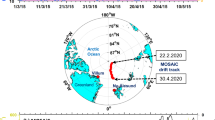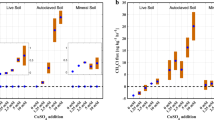Abstract
Volatile halogenated organic compounds (VHOC) play an important role in atmospheric chemical processes—contributing, for example, to stratospheric ozone depletion1,2,3,4. For anthropogenic VHOC whose sources are well known5, the global atmospheric input can be estimated from industrial production data. Halogenated compounds of natural origin can also contribute significantly to the levels of VHOC in the atmosphere6. The oceans have been implicated as one of the main natural sources7,8,9,10, where organisms such as macroalgae and microalgae can release large quantities of VHOC to the atmosphere11,12. Some terrestrial sources have also been identified, such as wood-rotting fungi13, biomass burning14 and volcanic emissions15. Here we report the identification of a different terrestrial source of naturally occurring VHOC. We find that, in soils and sediments, halide ions can be alkylated during the oxidation of organic matter by an electron acceptor such as Fe( III): sunlight or microbial mediation are not required for these reactions. When the available halide ion is chloride, the reaction products are CH3Cl, C2H5Cl, C3H7Cl and C4H9Cl. (The corresponding alkyl bromides or alkyl iodides are produced when bromide or iodide are present.) Such abiotic processes could make a significant contribution to the budget of the important atmospheric compounds CH3Cl, CH3Br and CH3I.




Similar content being viewed by others
References
Crutzen, P. J. & Arnold, F. Nitric acid clouds formation in the cold Antarctic stratosphere: a major cause for the springtime ‘ozone hole’. Nature 324, 651– 655 (1986).
Solomon, S. Progress towards a quantitative understanding of Antarctic ozone depletion. Nature 347, 347–354 (1990).
Anderson, J. G., Toohey, D. W. & Brune, W. H. Free radicals within the Antarctic vortex: The role of CFCs in the Antarctic ozone loss. Science 251, 39–46 (1991).
Wever, R. Ozone destruction by algae in the Arctic atmosphere. Science 355, 501 (1988).
Butler, J. H. et al. A record of atmospheric halocarbons during the twentieth century from polar firn air. Nature 399, 749– 755 (1999).
Gribble, G. W. Naturally occurring organohalogen compounds—a survey. J. Natural Prod. 55, 1353–1395 (1992).
Lovelock, J. E. Natural halocarbons in the air and in the sea. Nature 256, 193–194 (1975).
Singh, H. B., Salas, L. J. & Stiles, R. E. Methylhalides in and over the Eastern Pacific (40° N-32° S). J. Geophys. Res. 88, 3684– 3690 (1983).
Class, T. & Ballschmiter, K. Sources and distribution of bromo- and bromochloromethanes in marine air and surface water of the Atlantic Ocean. J. Atmos. Chem. 6, 35– 46 (1988).
Moore, R. M., Groszko, W. & Niven, S. J. Ocean-atmosphere exchange of methyl chloride: Results from NW Atlantic and Pacific Ocean studies. J. Geophys. Res. 101, 28529–28538 (1988).
Sturges, W. T., Sullivan, C. W., Schnell, R. C., Heidt, L. E. & Pollack, W. H. Bromoalkane production by Antarctic ice algae. Tellus B 45, 120– 126 (1993).
Laturnus, F. & Adams, F. C. Methylhalides from Antarctic macroalgae. Geophys. Res. Lett. 25, 773– 776 (1998).
Harper, D. B. Halomethane from halide ion—a highly efficient fungal conversion of environmental significance. Nature 315, 55–57 (1985).
Andreae, M. O. et al. Methylhalide emissions from savanna fires in southern Africa. J. Geophys. Res. 101, 23603– 23613 (1996).
Rasmussen, R. A., Rasmussen, L. E., Khalil, M. A. K. & Dalluge, R. W. Concentration of methyl chloride in the atmosphere. J. Geophys. Res. 85, 7350–7356 ( 1980).
Hoekstra, E. J., Lassen, P., van Leeuwen, J. G. E., De Leer, E. W. B. & Carlsen, L. in Naturally Produced Organohalogens (eds Grimvall, A. & De Leer, E. W. B.) 149– 158 (Kluwer Academic, Dordrecht, 1995).
Desjardins, S., Landry, J. A. & Farant, J. P. Effects of water and pH on the oxidative oligomerization of chloro and methoxyphenol by a montmorillonite clay. J. Soil Contamin. 8, 175–195 ( 1999).
Lovley, D. R. Dissimilatory Fe(III) and Mn(IV) reduction. Microbiol. Rev. 55, 259–287 (1991).
Post, W. M., Emanuel, W. R., Zinke, P. J. & Stangenberger, A. L. Soil carbon pools and world life zones. Nature 298, 156–159 (1982).
Acknowledgements
We thank D. Schlösser and K. Kratz for the instrumental neutron activation analysis (INAA) measurements and I. Fahimi and L. Warr for reviewing the manuscript.
Author information
Authors and Affiliations
Corresponding author
Rights and permissions
About this article
Cite this article
Keppler, F., Eiden, R., Niedan, V. et al. Halocarbons produced by natural oxidation processes during degradation of organic matter. Nature 403, 298–301 (2000). https://doi.org/10.1038/35002055
Received:
Accepted:
Issue Date:
DOI: https://doi.org/10.1038/35002055
- Springer Nature Limited
This article is cited by
-
Temporal and Spatial Distribution, Ecological Risk Assessment and source Identification of heavy Metals in the Surface Sediments of Lake Taihu Basin, China
Water, Air, & Soil Pollution (2023)
-
Biofilm Formation of Two Different Marine Bacteria on Modified PDMS Surfaces is Affected by Surface Roughness and Topography
Current Microbiology (2023)
-
Application of copper(II)-based chemicals induces CH3Br and CH3Cl emissions from soil and seawater
Nature Communications (2022)
-
Chlorine cycling and the fate of Cl in terrestrial environments
Environmental Science and Pollution Research (2021)
-
Influence Factors on Photochemical Production of Methyl Iodide in Seawater
Journal of Ocean University of China (2020)





